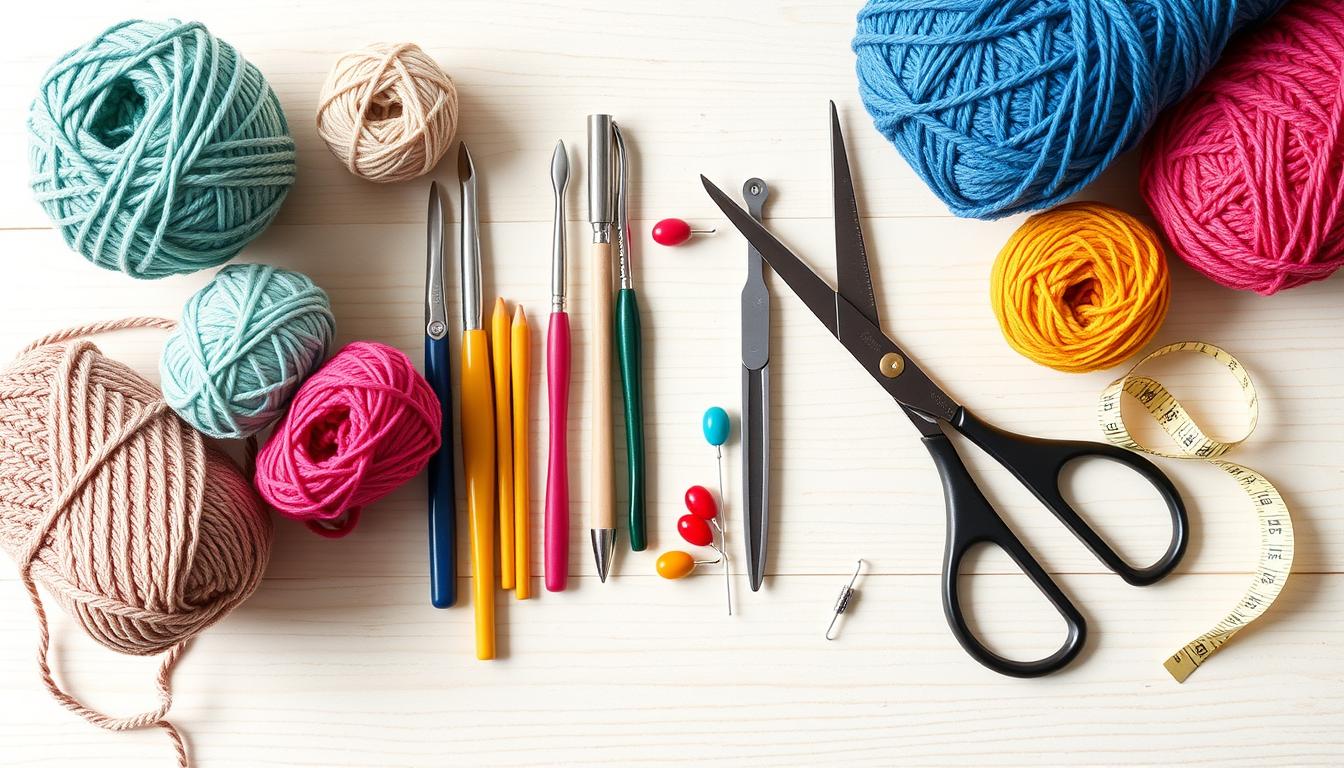
Crochet is a wonderfully creative and relaxing hobby that allows you to craft beautiful items with just a hook and some yarn. Having the right crochet essentials makes all the difference between frustration and enjoyment, especially when you're just starting out. This guide will walk you through everything you need to begin your crochet journey with confidence.
Whether you're looking to make cozy blankets, stylish garments, or cute amigurumi toys, the basic tools remain the same. Let's explore the essential supplies that will set you up for success in your first crochet project and beyond.
Why Having the Right Tools Matters
The right crochet tools can make your learning experience smoother and more enjoyable. Quality supplies help you create even stitches, maintain proper tension, and avoid common frustrations that might otherwise discourage you from continuing.
Using appropriate hooks for your yarn weight prevents splitting and snagging. Proper stitch markers help you keep track of your pattern. Sharp scissors make clean cuts that prevent fraying. Each tool serves a specific purpose in creating beautiful, lasting projects.
While it might be tempting to buy the cheapest options available, investing in good-quality basic tools will serve you better in the long run. You don't need to purchase the most expensive items, but choosing mid-range options will provide a better experience as you learn.
8 Essential Crochet Tools and Materials
Let's explore the must-have crochet essentials that every beginner should have in their toolkit. Each of these items plays an important role in creating successful projects.
1. Crochet Hooks
Crochet hooks are the primary tool you'll use to create your projects. They come in various materials (aluminum, plastic, bamboo, wood) and sizes, each offering different benefits. Aluminum hooks are smooth and fast, while wooden hooks provide more grip and warmth.
For beginners, I recommend starting with a medium-sized aluminum hook (size H/5.0mm) or an ergonomic hook with a comfortable grip. As you progress, you can expand your collection to include different sizes for various projects.
Ready to get started?
A quality hook makes learning easier. Try an ergonomic set with comfortable grips.
Shop Beginner-Friendly Hooks2. Yarn
Yarn comes in countless fibers, weights, and colors. For beginners, medium-weight (worsted weight or #4) acrylic or cotton-blend yarn in light colors is ideal. These yarns are affordable, easy to work with, and show stitches clearly.
Avoid very dark colors, fuzzy textures, or specialty yarns when you're first learning, as these can make it difficult to see your stitches. Once you've mastered basic techniques, you can experiment with different yarn types.
The yarn label provides important information about the recommended hook size, weight category, and care instructions. Always check this information before starting a project.
3. Scissors
A good pair of scissors is essential for cutting yarn cleanly. Small, sharp scissors work best and are easy to carry in your project bag. Some crafters prefer embroidery scissors or yarn snips specifically designed for fiber arts.
Keep your craft scissors separate from household scissors to ensure they stay sharp. Dull scissors can fray your yarn and make clean cuts difficult.
4. Tapestry Needles
Tapestry needles (also called yarn needles or darning needles) are blunt-tipped needles with large eyes used for weaving in ends and seaming pieces together. They come in different sizes and materials, with metal being the most common.
Look for a set that includes different sizes to accommodate various yarn weights. Both straight and bent-tip needles are useful for different finishing techniques.
5. Stitch Markers

Stitch markers help you keep track of important points in your work, such as the beginning of rounds, pattern repeats, or stitch counts. For crochet, you'll need openable markers (unlike the closed rings used in knitting).
Locking stitch markers that resemble small plastic safety pins are ideal for crochet. They can be attached and removed easily without damaging your work. You can also use paper clips or small pieces of contrasting yarn as budget-friendly alternatives.
6. Measuring Tape
A flexible measuring tape is essential for checking your gauge and measuring your projects. Look for a retractable tape measure that's easy to carry in your project bag. Make sure it shows both inches and centimeters for versatility.
Accurate measurements ensure your finished projects will be the right size, which is especially important for wearable items like hats, scarves, and garments.
7. Row Counter
A row counter helps you keep track of where you are in your pattern. This is especially useful for complex patterns or when you need to work a specific number of rows or rounds.
Row counters come in various styles, from simple mechanical clickers to digital counters that can track multiple counts at once. Some even come as apps for your smartphone or as features on digital pattern readers.
8. Project Bag
A dedicated project bag keeps all your supplies organized and your work-in-progress clean. Look for a bag with compartments for your hooks, scissors, and other small tools, plus room for your current project and yarn.
Having a portable project bag makes it easy to take your crochet with you, turning waiting time into productive crafting time. Many crafters have multiple project bags for different works-in-progress.
Get all your essentials in one place
Start your crochet journey with confidence using a complete beginner kit.
Shop Beginner Crochet KitsTips for Choosing the Right Crochet Tools
Selecting the Right Hook Size
The hook size you need depends primarily on your yarn weight and desired fabric density. Here's a quick reference guide:
| Yarn Weight | Recommended Hook Size | Common Projects |
| Lace (0) | Steel hooks or 1.5-2.25mm | Doilies, fine lace |
| Fingering (1) | 2.25-3.5mm (B-E) | Socks, delicate shawls |
| Sport/DK (2-3) | 3.5-4.5mm (E-7) | Baby items, lightweight garments |
| Worsted (4) | 5.0-6.0mm (H-J) | Scarves, hats, blankets |
| Bulky (5) | 6.5-9mm (K-M) | Quick blankets, thick scarves |
| Super Bulky (6) | 9mm+ (N and up) | Rugs, chunky blankets |
Choosing Yarn for Beginners
- Select medium-weight (worsted) yarn for your first projects
- Choose light, solid colors that make stitches easy to see
- Start with acrylic or cotton blends that are affordable and durable
- Avoid fuzzy, dark, or novelty yarns until you've mastered basic techniques
- Check the yarn label for recommended hook size and care instructions
Ergonomics Matter
Crochet should be comfortable and enjoyable. If you experience hand fatigue or pain, consider ergonomic hooks with larger, cushioned handles. These hooks distribute pressure more evenly across your hand and can prevent strain during longer crochet sessions.
Your posture and lighting also affect your crochet experience. Work in a well-lit area with good back support, and take regular breaks to stretch your hands, neck, and shoulders.
Common Mistakes to Avoid When Starting Crochet
Tool-Related Mistakes
- Using the wrong hook size for your yarn - Check the yarn label for recommendations
- Choosing dark or textured yarn as a beginner - Light, smooth yarn makes stitches easier to see
- Using dull scissors - Sharp scissors prevent yarn fraying
- Forgetting stitch markers - They help track your progress and prevent errors
- Skipping gauge swatches - Always check your tension before starting a project
Technique-Related Mistakes
- Crocheting too tightly - Relax your grip for even stitches
- Inconsistent tension - Practice maintaining even pressure on your yarn
- Losing count of stitches - Count regularly and use markers
- Skipping pattern reading - Read the entire pattern before starting
- Getting discouraged - Everyone makes mistakes; practice makes progress
"The joy of crochet is in its simplicity: there is only ever one stitch in work and just a few variations of the basic stitches to master, but the possibilities of using and combining those stitches together are endless."
Your First Crochet Project
Ready to put your new crochet essentials to use? A simple dishcloth or small square is the perfect first project. It allows you to practice basic stitches without committing to a larger project.
Beginner-Friendly Project Ideas:
- Simple dishcloth - Practice basic stitches with cotton yarn
- Basic scarf - Learn to maintain even tension over rows
- Granny square - Master working in the round
- Headband - Quick project with practical results
- Coaster set - Create small, useful items while learning
Pro Tip: Start with a small project you can complete in a few hours. The satisfaction of finishing will boost your confidence and motivation to continue learning!
Ready to Start Your Crochet Journey?

With these crochet essentials in your toolkit, you're well-equipped to begin your crochet journey. Remember that every expert crocheter was once a beginner, and practice is the key to improvement. Start with simple projects, be patient with yourself, and enjoy the process of creating something with your own hands.
The wonderful thing about crochet is that you can start with just a hook and some yarn, then gradually add to your collection as your skills and interests grow. Don't feel pressured to buy everything at once – focus on quality basics and expand your toolkit as needed.
Begin Your Crochet Adventure Today!
Get all the essential supplies you need and start creating beautiful handmade items.
Shop Crochet Essentials NowHappy crocheting!
FAQs
What is the absolute minimum I need to start crocheting?

At the very minimum, you need just a crochet hook and yarn. However, for a better experience, I recommend also having scissors and a tapestry needle for finishing your projects.
How much should I expect to spend on basic crochet supplies?
You can get started with quality basics for about $20-30. This would include a few hooks, a skein or two of yarn, scissors, and tapestry needles. As you advance, you can gradually add more specialized tools.
What's the difference between aluminum and ergonomic crochet hooks?

Aluminum hooks are typically thinner with a smooth surface that allows yarn to glide easily. Ergonomic hooks have thicker, cushioned handles designed to reduce hand fatigue and provide a more comfortable grip during longer crochet sessions.
Can I use knitting yarn for crochet projects?

Yes! Yarn sold for knitting can absolutely be used for crochet. The weight categories and fiber types are the same. Just be sure to check the recommended hook size on the yarn label.

Christa Patel is a passionate crochet educator and craft blogger with over a decade of yarn experience. She began her crochet journey as a stress-relieving hobby and quickly fell in love with its creative possibilities. Christa’s step-by-step tutorials and easy project guides have helped thousands of beginners pick up their first hook with confidence.
She believes everyone can make something beautiful, no matter their skill level. Through her blog and online community, Christa shares modern patterns, essential tips, and honest advice for crafters at every stage. When not crocheting, she enjoys exploring local markets for unique yarns and spending cozy evenings with family and her rescue pets.
Connect with Christa on her website secretyarnery.com, or follow her journey on Instagram @secretyarnery for daily inspiration and crochet encouragement.












